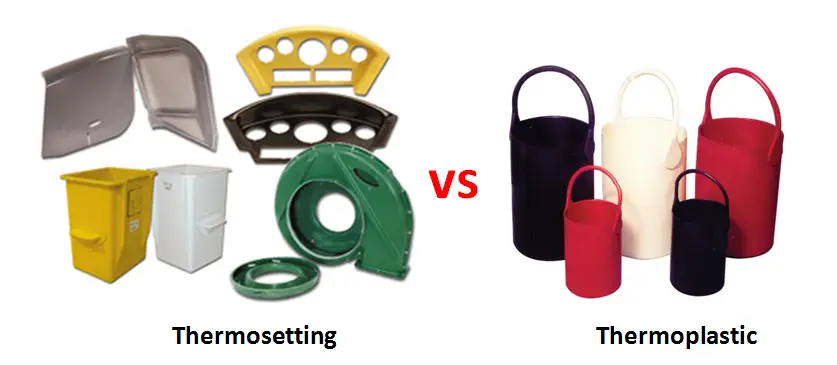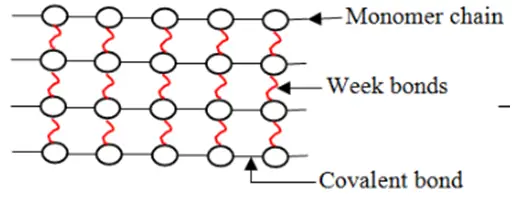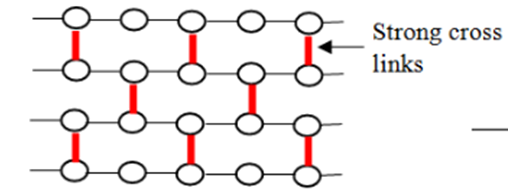While studying the engineering or chemistry, you must have heard about the thermosetting plastics and thermoplastic. But do you know the exact differences between these two types of plastics?
I am sure that most of you may be confused about both the words, thermosetting and the thermoplastic. They sound like they are similar but they are not similar. The basic point of difference between the thermosets and thermoplastics is that thermoplastics can be melted again into the liquid state while the thermosets cannot be melted once they take the form of the solid state.

Do you still not understand the above basic difference? Don’t worry I am now taking the real-life examples to distinguish the difference between these two types of plastic. Consider a butter, which can be heated as well as melted to form the various shapes. And the butter is nothing but the thermoplastic. Now, think of a bread. The bread is nothing but the thermosetting plastic. As bread cannot be melted again. So, same case of bread holds true for the thermosetting plastic.
Thermoplastic

If you see the above image then, it shows that the thermoplastic has a week bond.
Thermosetting plastic
Above image indicates that the thermosetting plastic have a stronger bond.
Physical Properties
If you consider the physical properties like stiffness, tensile strength then, these have higher values in case of the thermosetting plastic. And thermoplastics have lower values of these physical properties.
Now, we will move further and will deeply analyse both the types of the plastic in the tabular format. So, that you can easily understand the difference between thermosetting and thermoplastic.
Also Read:
- What is Powder Metallurgy – A Modern Manufacturing Process
- What is Induction Heating?
- Types of plastics – That You Must Know?
| S.no |
Thermosetting Plastic |
Thermoplastic |
|
1. |
Thermosetting plastic are known for their high molecular weight. | If you consider the thermoplastics then, they have a low molecular weight. |
|
2. |
A process of condensation polymerisation is used in the making of the thermosetting plastic. | A process of addition polymerisation is used in the making of the thermoplastics. |
|
3. |
In the thermosetting plastic, a primary bond is present between the molecular chains. | In the thermoplastics, a secondary bond is present between the molecular chains. |
|
4. |
As the bonding between the intermolecular chains is strong, they have higher melting point. | Due to the presence of the weak intermolecular bonding between the molecular chains, the thermoplastics have a lower melting point. |
|
5. |
Thermosets have a brittle nature. | If you consider the thermoplastics then, they have flexible nature. |
|
6. |
They have the capability of not dissolving in the solvents that are organic | They are capable of dissolving in the organic solvents. |
|
7. |
As they are hard and not flexible, they are not easy to recycle. | Thermoplastics can be easily recycled. |
|
8. |
Bakelite, Epoxy Resin, Polyurethanes, Polyester Resins, Urea-formaldehyde are the examples of the thermosetting plastics. | Nylon, Acrylic, Teflon, Polyvinyl Chloride, Polyethylene are the examples of the Thermoplastic. |
|
9. |
They are more durable. | Thermoplastics are less durable. |
|
10. |
They are economical as they have low cost. | Due to the slightly higher cost than the thermosetting plastic, they are less economical. |
|
11. |
Thermally, thermosetting plastic are more stable. | Thermally, thermoplastics are less stable. |
|
12. |
Reaction injection moulding, compression moulding are used to process the thermosetting plastic. | They are easier to process with the rotational moulding, injection moulding, extrusion process, etc. |
Disadvantages of Thermoplastics
- They are sensible to heat and UV radiations and it affects the environment drastically.
- Degradation of polymer takes place after recycling too much.
Disadvantages of the Thermosetting plastic
- If you do the welding of the thermosetting plastic then, they are not easy to blend during the process.
- In the manufacturing, time consuming and lengthy processes are involved.
So, this is all about the difference between the thermosetting and thermoplastic. If you have any more question related to above two types of plastic then, feel free to comment below. Until then keep reading, keep sharing.

